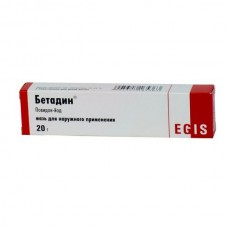Expiration date: 12/2026
Structure and Composition:
Ointment for external application
1g contains povidone-iodine 100 mg
Excipients: sodium bicarbonate Macrogol 400 Macrogol 4000 Macrogol 1000 Macrogol 1500 Purified water
in tubes of 20 g of aluminum in the paper cartons 1 tube.
Description pharmaceutical form:
Ointment brown iodine weak odor.
Pharmacokinetics:
When applied topically hardly occurs iodine absorption.
Description of the pharmacological actions:
Antiseptic and disinfectant. When released from a complex with PVP, in contact with skin and mucous membranes, iodine reacts with proteins yodaminy bacterial cells, it coagulates them and causes the death of microorganisms. It provides rapid bactericidal activity against gram-positive and gram-negative bacteria (except for M. tuberculosis). Effective against fungi, viruses, protozoa.
Testimony:
- Bacterial and fungal skin infections
- burns
- trophic ulcers
- bedsores
- infectious dermatitis
- abrasions
- wounds.
Contraindications:
- Hypersensitivity to iodine and other components of the drug
- dysfunction of the thyroid gland (hyperthyroidism) (see section "Special Instructions")
- thyroid adenoma
- dermatitis herpetiformis Duhring
- the simultaneous use of radioactive iodine
- premature and newborn babies (see. "Special Instructions" section).
Precautions: Pregnancy and lactation, chronic renal failure.
Application of Betadine is not recommended with the 3rd month of pregnancy and during lactation. If necessary, in these cases, treatment is possible for the individual medical supervision.
Side effect:
With the frequent use of a large area of ??the wound surface and the mucous membranes may occur systemic reabsorption of iodine, which may affect the functional activity of the thyroid tests.
Hypersensitivity reactions to the drug, possibly a manifestation of allergic reaction (redness, burning, itching, swelling, pain), which requires discontinuation of the drug.
Drug Interactions:
Incompatible with other disinfectants and antiseptic agents, particularly those containing alkali, enzymes and mercury.
The presence of blood bactericidal effect can be reduced, however, by increasing the drug concentration, the bactericidal activity can be enhanced.
Dosage and administration:
Outwardly. Ointment applied thinly to the affected area 2-3 times a day can be used under occlusive dressing.
Special instructions:
When violations of thyroid function use of the drug is possible only under strict medical supervision.
Use of the drug in neonates is only possible, if necessary, after study of thyroid function.
Caution should be exercised when used regularly on damaged skin in patients with chronic renal failure.
The application site is formed painted film, continuing to release the total number of active iodine, its disappearance means the cessation of the drug.
Painting on the skin and tissues is easily washed off with water.
DO NOT use insect bites, domestic and wild animals.
Avoid contact with the eyes of the drug.


